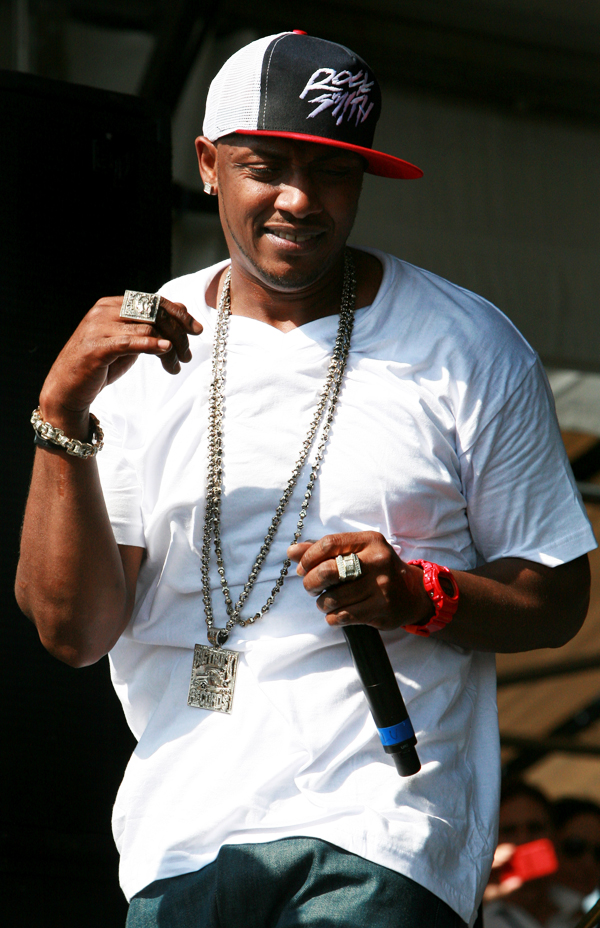Rap, Hip-Hop, and Bounce Music
Rap, hip-hop, and bounce are musical genres that developed in New Orleans beginning in the late 1980s.

Gary LoVerde
Mystikal performing at the New Orleans Jazz & Heritage Festival, 2011. Gary LoVerde, photographer.
New Orleans, with its rich history of African American musical traditions, has occupied a central place in the history of hip-hop in Louisiana, although several notable rap artists have emerged from other cities like Baton Rouge. Building on a decade of local activity, rappers and DJs in New Orleans during the early 1990s created a new local style of hip-hop that was eventually christened “bounce.” While the style remained regionally limited, the bounce scene helped support the growth of a local industry. However, the city’s distance from hip-hop’s initial centers of activity (New York and later Los Angeles) meant that it would take a significant amount of time for New Orleans–based rappers, producers, and record labels to penetrate the commercial mainstream. Building on the early foundation, several independent record labels, including No Limit and Cash Money, captured national audiences in the late 1990s, and helped establish New Orleans as one of the centers of the “Dirty South” style. New generations of artists and companies emerged in the early twenty-first century, but many of those suffered a major setback in the form of Hurricane Katrina–related disruption.
Early Rap in New Orleans
Locally established record labels and producers were responsible for some of the earliest rap recordings to come out of New Orleans. These included singles by Parlez (on Senator Jones’s Superdome label) and Jones and Taylor Experience (on Soulin’ Records), among others. New York Incorporated, a group of several DJs and rappers led by transplanted New Yorker Denny Dee, was one of the first devoted exclusively to hip-hop. It included Byron Thomas and Mia Young, who would go on to later fame as Mannie Fresh and Mia X, respectively. Other groups from this period included Rockers Revenge and the Ninja Crew (composed of rappers Gregory D and Sporty T, and DJ Baby T), who released a single in 1986 on the Miami-based 4-Sight label.
After Ninja Crew disbanded, Gregory D partnered with Mannie Fresh to form a duo that would prove to be one of the most prolific rap groups of the late 1980s. The pair released records on the Yo! Label, based in Dallas, Texas, and the Los Angeles–based D&D. While they produced music that was largely indistinguishable from mainstream commercial rap, their two-song single on the local Uzi Records was a groundbreaking expression of the local hip-hop sensibility, relying on participatory, call-and-response-based cadences, and references to the city’s housing projects and other poor or working-class areas where hip-hop was taking root.
Other rappers and producers attained prominence in the late 1980s. MC J Ro J’s single “Let’s Jump” was the first local hip-hop tune to sample music from New Orleans’s second line brass band tradition. Other important groups from the period included the Famous Low Down Boys and E. R. C. Several rappers from the West Bank area of greater metro New Orleans achieved prominence, including MC Thick, whose single “Marrero” led to a contract with a subsidiary of Atlantic Records. Other West Bank rappers included Tim Smooth, who signed with Yo! and later, Rap-a-Lot. Ice Mike, who had built his production and rapping skills as a member of the Def Boyz, released records as a solo artist and produced records for others, most prominently BustDown, who was signed to Effect Records, based in Miami, Florida. Club owner and promoter Warren Mayes had a local hit with the chant-heavy song “Get It Girl,” which was released as a single by Atlantic Records in 1991. Several rap groups, including Full Pack and 39 Posse, started their own independent labels, through which they released recordings of themselves and others.
Bounce
In late 1991, a distinctive local style emerged in New Orleans, based on the efforts of rappers and DJs working in small nightclubs and block parties, or large outdoor gatherings of dancers and spectators. At a club called Ghost Town, MC T. Tucker rose to local fame with a song called “Where Dey At” over DJ Irv’s backing music, largely derived from the 1986 single “Drag Rap” by the New York–based group called the Showboys. While Tucker’s song was only released in the form of a crude, bootleg-quality live recording, its local popularity inspired a more polished studio recording by DJ Jimi, “(The Original) Where They At,” on Isaac Bolden’s Soulin’ Records, which appeared in Billboard charts. A full-length album, It’s Jimi, was released in 1992. It was produced by Leroy “Precise” Edwards and featured the debut of teenage rapper Juvenile on the cut titled “Bounce (for the Juvenile).” This formed the basis for the local subgenre called “bounce,” defined by a tempo ranging from 95 to 105 beats per minute, chanted call-and-response vocals, references to New Orleans wards and neighborhoods, and a swinging, polyrhythmic accompaniment based in certain characteristic samples and bass drum patterns.
Seminal releases by artists including Silky Slim, Lil Slim, Sporty T, Pimp Daddy, and others followed. Bounce quickly came to dominate the New Orleans hip-hop scene in the early 1990s, but the idiosyncratic style stayed constrained to the city’s immediate area. Still, the local enthusiasm for bounce helped establish several important local companies. Cash Money Records began in 1992 and soon rose to prominence, as evidenced by sales at outlets like Peaches and Odyssey. Owned by brothers Bryan (“Baby”) and Ronald (“Slim”) Williams, the label released a variety of gangsta rap and bounce artists, including Kilo G, M$ Tee, and the trio UNLV. Several other record labels formed in the early 1990s, including Big Boy, with in-house producer Precise, and Take Fo’, which released records by the female duo Da’ Sha Ra’ and DJ Jubilee, among others. Magnolia Slim, later known as Soulja Slim, released several recordings during this era, including a full-length cassette for the local Parkway Pumpin label.
Breaking Through to the Mainstream
The isolation of New Orleans hip-hop from the national mainstream ended in 1995, when Michael “Mystikal” Tyler signed with Jive Records. His debut album for Big Boy Records was re-released with the new title Mind of Mystikal, the first of several successful releases for the energetic rapper. Despite many local references in his lyrics, Mystikal’s music was not linked to New Orleans bounce.
Meanwhile, New Orleans native Percy “Master P” Miller was in the process of building an underground gangsta rap empire that would see him become one of the richest entertainers in the world. Miller founded the No Limit label while he was living in Richmond, California, but the enterprise took off after he returned to New Orleans and enlisted several prominent local artists, including Mia X and producer Craig “KLC” Lawson. Along with several other producers, KLC formed part of a group known as Beats by the Pound (later the Medicine Men) who produced music for the label in its heyday. No Limit’s early releases included the group TRU, as well as several albums by Master P himself. In 1995 the label recorded several promising local artists for the Down South Hustlers compilation, including Joe Blakk, Mia X, Skull Duggery, Magnolia Slim, and others. In 1996 No Limit sealed a “pressing and distribution” deal with Priority; the label sold millions of copies of subsequent releases by Master P, his brothers C-Murder and Silkk the Shocker, Mia X and, later, Mystikal.
While No Limit’s success was groundbreaking for New Orleans, it was followed in 1998 by a similar deal between Cash Money and Universal. The agreement helped Juvenile’s second album for the label, 400 Degreez, sell more than three million copies, with bounce-flavored songs like “HA” and “Follow Me Now” winning over critics and audiences nationwide. Juvenile’s success was soon followed by other hits, including B. G.’s iconic song “Bling Bling,” on his album Chopper City in the Ghetto.
Recent Trends
Beginning around 2000, New Orleans saw the emergence of a cohort of openly gay male rappers, called “sissies” or “punks.” Led by Take Fo’ artist Katey Red, this contingent also included Vockah Redu, Sissy Nobby, and Big Freedia. Other rappers like Gotti Boi Chris and 10th Ward Buck helped return New Orleans rap to a local orientation, with collective participation driven by chanted call-and-response lyrics. Labels including Black House and Money Rules formed part of the newest wave of grassroots activity in the city. However, local favorite Soulja Slim was murdered in 2003, just as his national career was taking off after a high-profile collaboration with Juvenile.
The New Orleans hip-hop scene had barely recovered from this shock when Hurricane Katrina struck, scattering rappers and producers to nearby cities like Baton Rouge, Houston, Dallas, and Atlanta, where they struggled to keep their careers moving forward. Lil’ Wayne, who relocated to Miami after the disaster, has risen to become one of the nation’s most popular rappers.
